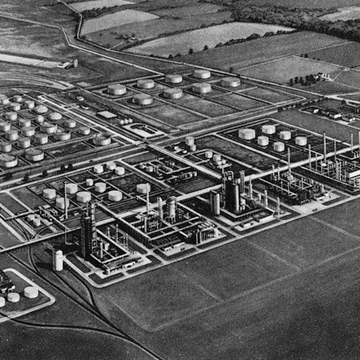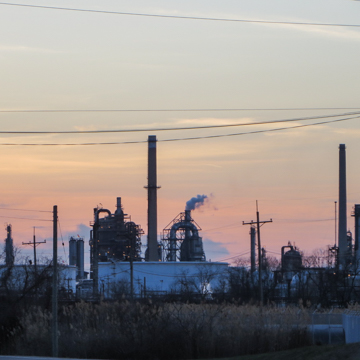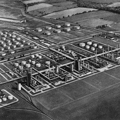You are here
Delaware City Refinery (Tidewater Delaware Refinery)
Tidewater Oil Company marketed its products nationwide as Flying A Gasolines and Veedol Motor Oils. It examined thirty sites on the Eastern Seaboard before choosing this one, 5,000 acres of farmland centered on the historic Philip Reybold peach mansion, Lexington (1846, Samuel Sloan). The company torched the mansion (July 1955) and erected the largest refinery ever built at one time, a facility that could process 130,000 barrels of crude oil per day. Nine thousand men were at work erecting the plant in 1956. At its heart was the twenty-five-story-high Fluid Catalytic Cracker for converting gas oils into gasoline, said to be the largest in the world at the time. A huge marine terminal was dredged, and nine million barrels of river water were pumped through the refinery per day for cooling, more than the volume used by Philadelphia. Indeed, the gigantic facility resembles a city in itself when its towering smokestacks and thousands of lights are seen from across the fields at night. Delaware City welcomed the plant eagerly, but some residents later grumbled about the limited financial benefits to the town and the acrid smells. From his farm at Buena Vista (NC24), former Governor C. Douglass Buck complained in 1958 that the plant had turned “peaceful” farmland into “a smelly unattractive section.” Fearing more refineries, the state legislature eventually passed the historic Coastal Zone Act banning heavy industry (1971). Tidewater Refinery has subsequently changed hands many times and remains controversial for its groundwater pollution and toxic releases.
Writing Credits
If SAH Archipedia has been useful to you, please consider supporting it.
SAH Archipedia tells the story of the United States through its buildings, landscapes, and cities. This freely available resource empowers the public with authoritative knowledge that deepens their understanding and appreciation of the built environment. But the Society of Architectural Historians, which created SAH Archipedia with University of Virginia Press, needs your support to maintain the high-caliber research, writing, photography, cartography, editing, design, and programming that make SAH Archipedia a trusted online resource available to all who value the history of place, heritage tourism, and learning.





